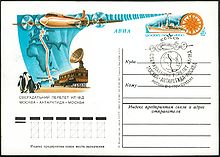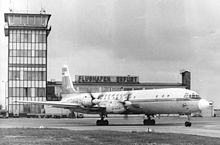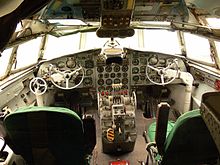Ilyushin Il-18
| Ilyushin Il-18 | |
|---|---|
 Il-18 of the Rossiya |
|
| Type: | Four-engine passenger aircraft |
| Design country: | |
| Manufacturer: | |
| First flight: |
4th July 1957 |
| Commissioning: |
1959 |
| Production time: |
1959 to 1978 |
| Number of pieces: |
more than 850 |
The Ilyushin Il-18 ( Russian Ильюшин Ил-18 , NATO code name : Coot ) is a four-engine passenger aircraft manufactured by the Soviet manufacturer Ilyushin . The type is equipped with a retractable landing gear , turboprop drive and a pressurized cabin . The first flight took place on July 4, 1957 under test pilot Vladimir Kokkinaki .
history
The Aeroflot demanded mid-1950s, a new aircraft for 75 to 100 passengers. Based on the Il-18 type from 1946 , which never reached series production, Ilyushin knew how to produce a sample that met the requirements as early as 1957. The basic version, of which 20 machines were made, had space for 75 passengers. It was delivered to Aeroflot from 1959. After that, the Il-18B was made for 84 passengers. There are other versions that differ in terms of seating and range. The largest variant is the Il-18D for 122 passengers.
Aeroflot and the Soviet Air Force used around 600 machines of this type, and 100 more were exported. After the end of its use with Aeroflot as a passenger aircraft, a number of Ilyushin Il-20 reconnaissance aircraft , Ilyushin Il-22 as a flying control station and Ilyushin Il-38 anti-submarine aircraft were converted in the Soviet Union and in Russia .
In December 2008, 84 machines were still in service (in countries of the former Soviet Union, in Cuba and in North Korea).
construction
The Il-18 has a fuselage with a diameter of 3.5 m and a pressurized cabin. Due to the accident with the Comet , the outer skin was reinforced in over 150 places. The cabin was originally designed for 75 passengers and a 5-man crew. Luggage and cargo compartments are located under the cabin, of which the cargo compartment in the rear is not pressurized.
The wings are designed as trapezoidal surfaces with two-part double slotted flaps on the trailing edges and manually operated ailerons . Rudder and elevator are also operated manually. The tail unit is designed as a conventional tail unit. Folding tanks are built into the inner wings between the wing spars. Integral tanks have been used in the outer wings.
The main landing gear is four-wheeled and, after the wheel nacelle has been folded forward, retracts 90 ° forward into the inner engine nacelle. The nose wheel is also retracted forwards. This is intended to enable the chassis to fall out in a controlled manner in the event of hydraulic failures. The large landing gear doors are only open during the retraction or extension process. Small landing gear doors remain open when they are extended.
The drive of the Il-18 consists of four PTL engines, which are arranged in gondolas above the wings. The first production aircraft had NK-4 engines, which were later replaced by slightly modified engines of the Il-18A, renamed AI-20. The aircraft has four-blade controllable pitch propellers for propulsion.
Flight tests and records
On April 4, 1957, the first flight of the prototype, called Moskva ( Moscow ), took place with test pilot Vladimir Kokkinaki and the preliminary (Cyrillic) aircraft registration number СССР-Л5811 . The factory and state approval tests ran until August 27, 1958. Almost at the same time, a field test by Aeroflot ran from January 1958 to April 1959.
Several flight records were flown with the Il-18 and reported to the FAI . These include two climb records on November 14 and 15, 1958 with a payload of 15 t at 12,471 m and a payload of 10 t at 13,154 m. Two sightseeing flight records were also reported; On August 19, 1959, a distance of 2000 km and a payload of 15 t was covered at 719.4 km / h. On February 2, 1960, a 10 t payload was transported over a distance of 5000 km at a speed of 693 km / h.
variants


- Il-18A
- Basic version, which was produced in 20 copies at the Moscow-Chodinka aircraft plant from November 1958 . After several incidents it was decided that the AI-20 should be used instead of the NK-4 engine.
- Il-18B
- From the 21st production copy, the more powerful AI-20K engine with the AW-681 four-blade propeller was built into the Il-18. This version now had an increased take-off mass and payload and was set up for pressure refueling . The cabin was enlarged to 84 passengers.
- Il-18W
- The variant most built from spring 1961 to 1965 had a cabin for 100 passengers. Other changes to the cabin included rearranging the doors and windows to reduce noise pollution from the engines. Reading lights and fresh air nozzles were installed above the seats.
- Il-18D
- The version, originally designated as Il-18I, was produced from 1964. This version received AI-20M engines with 4,310 PS (3,170 kW), which led to a maximum take-off mass of 64,000 kg over a take-off distance of 1370 m. Additional tanks were installed in the wing center section. This increased the range to 6500 km. By moving the rear pressure bulkhead towards the stern, the cabin was enlarged and there was room for up to 122 passengers in a narrow seating arrangement.
- Il-18E
- This version is identical to the Il-18D except for the additional tanks and was produced at the same time.
- Il-18M
- An Il-18W was converted into a short-range version for flights of 1,600 km. The passenger capacity should be increased up to 126. Further design changes concerned the control systems.
- Il-18TS
- A version of the Il-18 as an ambulance aircraft.
- Il-18T
- Freighter version, which was created by converting decommissioned passenger versions. The aircraft was fitted with a 3.5 m wide power-operated cargo door at the rear. In addition, the cabin floor was reinforced with aluminum and titanium plates and equipped with a roller system. About 200 aircraft were converted.
- Il-18Gr
- Freighter version from converted passenger aircraft such as Il-18T, without cargo door.
- Il-18GrM
- Freighter version from converted passenger aircraft, with cargo door.
- Il-18DORR
- Version for the detection of schools of fish
- Il-18ZAO "cyclone"
- Version of a meteorological research aircraft.
- Il-18GGO
- Geophysical research aircraft
- Il-18LL
- Research aircraft for the aviation industry
- Il-18N
- Version for ice reconnaissance
- Il-18USch
- Training aircraft for navigators
- Il-22
- Flying command post (Wosduschny komandny point) of the Russian armed forces
Use and export

Originally the Il-18 was planned to support or replace the Li-2 and the Il-12 on the Aeroflot route network. On April 20, 1959, the scheduled service began with Aeroflot. To this end, two Il-18s took off from Moscow-Vnukowo Airport on that day to the destinations Alma-Ata and Sochi-Adler . In 1960, 72 lines were served with Il-18. In 1962 there were 210, 1964 334 and 1966 over 500 destinations that were flown to with Il-18. In the 1960s and 1970s, about a third of Aeroflot's annual transport volume was handled with Il-18.
In December 1961, an Il-18W landed for the first time in Antarctica , for which the fuel supply had been increased to 31,000 liters. In December 1963 two machines of this type landed in Antarctica. Since 1980 this route has been flown several times a year with Il-18D. At the end of March 1977 an Il-18 landed for the first time at the research station SP-22 on drifting ice in the Arctic Ocean.
With the Il-18, Ilyushin also achieved great success on the export market. Over 120 Il-18s were delivered primarily to states of the Council for Mutual Economic Assistance . Customers included Bulgaria, China, Cuba, North Korea, Poland, Romania, Czechoslovakia, Hungary and Vietnam. Other users were Afghanistan, Egypt, Algeria, Ghana, Guinea, Yemen, Yugoslavia, Mali and Mauritania. From 1960, 16 copies were delivered to the GDR and used by Deutsche Lufthansa and later by Interflug . Until the introduction of the Tu-134 and Il-62, they were the only aircraft used on the medium and long-haul routes of these airlines. The government aircraft of the NVA used six Il-18s in the salon variant, for example for state visits .
Incidents
From 1958 to October 2018 there were 100 total losses while operating the IL-18. There were 2501 deaths. Examples:
- On April 4, 1963, an Ilyushin Il-18 crashed on the domestic scheduled flight Aeroflot Flight 25 from Moscow to Krasnoyarsk, killing all 67 occupants.
- On November 24, 1966, an Il-18W of the Bulgarian TABSO ( aircraft registration LZ-BEN) was flown 8 kilometers from Bratislava Airport (Czechoslovakia) into the surrounding mountains after take-off . All 82 people on board were killed.
- On November 16, 1967, an Aeroflot Il-18W (CCCP-75538) crashed into a field three kilometers east of Yekaterinburg Airport shortly after taking off from Tashkent Airport . After taking off, an engine fire had occurred; however, the propeller in question could not be brought into the sail position . The increased aerodynamic drag in connection with the maximum take-off weight resulted in a loss of control and a crash at a height of 200 meters. None of the 99 passengers and 8 crew members survived the crash.
- On September 3, 1968, an Il-18E of the Bulgarian Bulair (LZ-BEG) was flown into the ground on the return flight from Dresden on the approach to Burgas Airport . When flying around showers and a thunderstorm, the machine was flown off-road at a height of almost 200 meters near Karnobat, 45 kilometers from the destination airport. In this CFIT ( Controlled flight into terrain ), 47 of the 89 people on board were killed.
- On March 20, 1969, an Il-18D of the Egyptian United Arab Airlines ( SU-APC ) crashed on an unscheduled flight from Jeddah to Aswan landing at the destination airport and went up in flames. Only 5 of the 105 people on board survived the accident. When approaching the poorly equipped airport in a sandstorm, the pilots flew below the decision height , also due to their excessive fatigue due to long working hours without suitable rest periods.
- On March 26, 1979, an Ilyushin Il-18D (DM-STL) of Interflug crashed shortly after taking off from Luanda Airport in Angola. A drop in power on one of the engines meant that the overloaded machine could not gain altitude in the high outside temperatures. It crashed into a hollow behind the runway. Several explosions and fires completely destroyed the aircraft. All ten occupants were killed (see also Luanda plane disaster ).
- On December 24, 1982, a fire broke out on board an Il-18B shortly before landing at Guangzhou-Baiyun Airport (old) . The machine of the state-owned Chinese airline CAAC Airlines landed safely and an evacuation was initiated. Of the 69 people on board, 25 died and 37 were injured. The fire was caused by the cigarette that a passenger accidentally dropped into an inaccessible gap between the seat rail and the inside wall of the cabin (see also CAAC flight 2311 ) .
- On January 18, 1988, an Ilyushin Il-18D of China Southwest Airlines (B-222) crashed while approaching Chongqing-Jiangbei Airport about 32 kilometers from its destination. The cause was the tearing off of one engine and the failure of another. All 108 people on board (10 crew members and 98 passengers) were killed (see also China Southwest Airlines flight 4146 ) .
- On November 15, 1992, an Il-18D of the Cuban Aerocaribbean (CU-T1270) was flown into a mountain 14 kilometers from its destination while approaching Puerto Plata Airport ( Dominican Republic ). None of the 34 occupants survived this controlled flight into terrain (CFIT).
Technical specifications
| Parameter | Data Ilyushin IL-18D |
|---|---|
| length | 35.90 m |
| height | 10.17 m |
| span | 37.40 m |
| Wing area | 140 m² |
| drive | four Ivchenko AI-20M turboprop engines |
| power | 4,310 PS (3,170 kW) each |
| Propellers | AW-68 I (4.5 m diameter) |
| Auxiliary power system | TG-16M (28 volt DC power supply with starter generator GS 24) |
| Empty mass | 35,000 kg |
| Takeoff mass | Max. 64,000 kg |
| Rolling mass | Max. 64,500 kg |
| Landing mass | Max. 52,600 kg |
| payload | Max. 13,500 kg |
| Empty tank mass | Max. 48,800 kg |
| fuel | Max. 30,000 l (24,000 kg) |
| Top speed | 675 km / h |
| Cruising speed | 650 km / h |
| Service ceiling | 10,000 m |
| Range | 6,500 km |
| Takeoff route | 1,370 m |
| Passengers | Max. 120 |
| crew | 4 (commander, co-pilot, flight engineer, navigator) + 2–3 flight attendants |
| All weather suitability | ICAO CAT 1 (operating level I) 60 m decision height / 800 m (visibility) or 550 m runway visibility |
See also
literature
- Ulrich Queck: PTL IL-18 Moskwa . Urania Universum , Volume 7, 1961, pp. 198-206
- Ulrich Unger: Ilyushin IL-18 . In: Peter Bork (Ed.): Fliegerkalender der DDR 1987 . Military Publishing House of the GDR, Berlin 1986, p. 207-214 .
- Ilyushin Il-18 . In: de Agostini (ed.): Aircraft. The new encyclopedia of aviation . No. 47 . Topic, Munich-Karlsfeld 1993, p. 1289-1295 .
- Jefim Gordon , Dmitri Komissarow: Ilyushin-18 / -20 / -22 A Versatile Turboprop Transport . Midland, Earl Shilton 2004, ISBN 1-85780-157-1 .
Web links
- Ilyushin Il-18 ( Memento from August 16, 2013 in the Internet Archive ) on the manufacturer's website
- The flight simulator of the Ilyushin IL-18 is currently being rebuilt in the "Hugo Junkers" technology museum in Dessau
- 360 ° shot of the cockpit of the machine still in operation in North Korea
- Video document IL-18 on youtube (Russian)
Individual evidence
- ↑ Manfred Meyer: The aircraft of the GDR . 1st edition. Bild und Heimat, Berlin 2013, ISBN 978-3-86789-439-5 , p. 14 .
- ^ Detlef Billig, Manfred Meyer: Airplanes of the GDR . 2nd Edition. tape 1 to 1962. Motorbuch, Stuttgart 2002, ISBN 3-613-02197-8 , pp. 144-151 .
- ↑ Accident statistics Ilyushin Il-18 , Aviation Safety Network (English), accessed on November 5, 2018.
- ^ Accident report IL-18V LZ-BEN , Aviation Safety Network (English), accessed on December 28, 2018.
- ^ Accident report IL-18V CCCP-75538 , Aviation Safety Network (English), accessed on November 5, 2018.
- ^ Accident report IL-18E LZ-BEG , Aviation Safety Network (English), accessed on June 24, 2020.
- ^ Accident report IL-18D SU-APC Aswan Airport (ASW) , Aviation Safety Network (English), accessed on June 18, 2018.
- ^ Accident report IL-18D B-222 , Aviation Safety Network (English), accessed on January 27, 2019.
- ^ Accident report IL-18 CU-T1270 , Aviation Safety Network (English), accessed on September 20, 2019.




